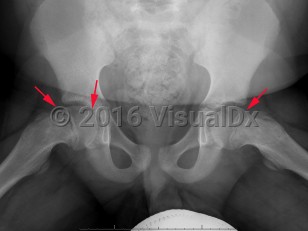Slipped capital femoral epiphysis
Alerts and Notices
Important News & Links
Synopsis
Classic history and presentation: This condition most commonly presents with groin, thigh, hip, and/or knee pain. The pain can be chronic or acute and can be constant or occur only when weight-bearing. Pain is more often unilateral but can occur bilaterally.
Prevalence: This is one of the most common disorders affecting the hips of adolescent patients. The prevalence varies from 0.71-10.8 per 100 000 children. The average age of onset is 12.7 years; it affects boys more often than girls at a rate of 1.5:1.
Risk factors: The greatest risk factor for SCFE is obesity. The average age at which this condition presents is decreasing, which has been correlated with the rise in pediatric obesity. Other risk factors include acetabular retroversion, femoral retroversion, history of previous radiation therapy to the femoral head region, and underlying endocrinologic disorders.
Pathophysiology: SCFE occurs due to mechanical forces acting on the growth plate as there is a weakness in the hypertrophic zone. In adolescents, there are increased shearing forces as the growth plate is still vertical and the perichondrial ring is thin and weakened. These increased shearing forces result in the femoral head shifting off the femoral neck through the growth plate.
Grade / classification system: SCFE can be categorized as stable or unstable. With a stable SCFE, the patient can bear weight on the affected leg with or without crutches; with an unstable SCFE, the patient is unable to bear weight on the affected leg. Unstable SCFE is correlated with a high risk of osteonecrosis and is a medical emergency.
Another classification tool is the Southwick slip angle classification. This uses the epiphyseal-diaphyseal angle, which can be measured on both anteroposterior (AP) and frog-leg lateral pelvis imaging. SCFE can be classified as mild if the angle is less than 30 degrees, moderate if between 30 and 50 degrees, and severe if greater than 50 degrees.
Less commonly used is the temporal classification, based on the duration of symptoms. SCFE is considered acute if symptoms persist for less than 3 weeks, chronic if the symptoms persist for more than 3 weeks, or acute-on-chronic if there is acute exacerbation of previously existing symptoms.
Codes
M93.003 – Unspecified slipped upper femoral epiphysis (nontraumatic), unspecified hip
SNOMEDCT:
26460006 – Slipped upper femoral epiphysis
Look For
Subscription Required
Diagnostic Pearls
Subscription Required
Differential Diagnosis & Pitfalls

Subscription Required
Best Tests
Subscription Required
Management Pearls
Subscription Required
Therapy
Subscription Required
Drug Reaction Data
Subscription Required
References
Subscription Required
Last Updated:05/01/2022

